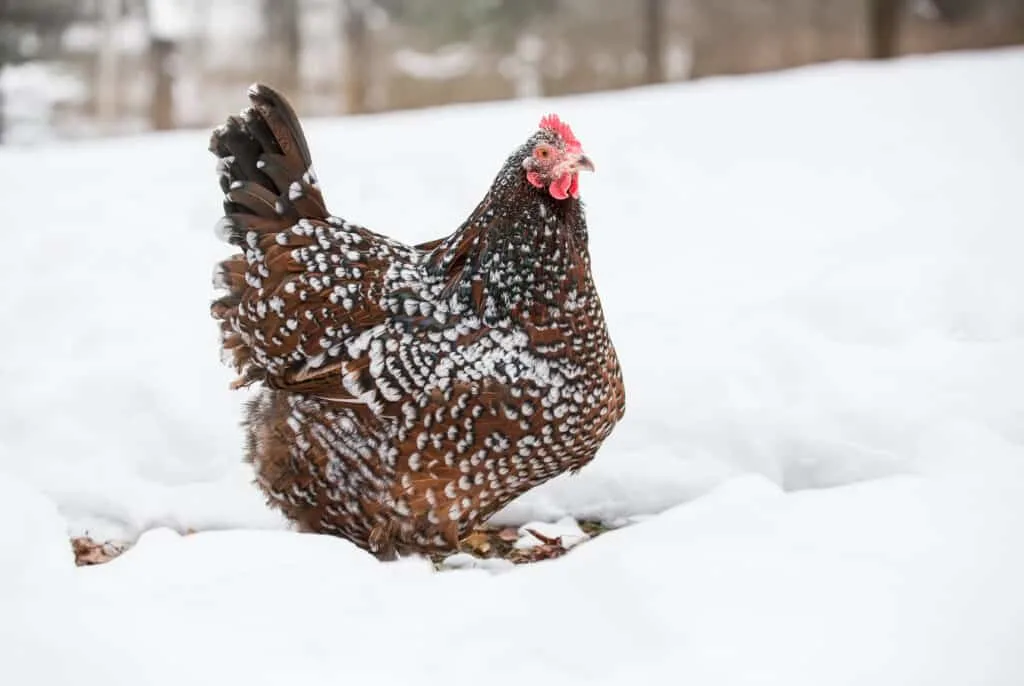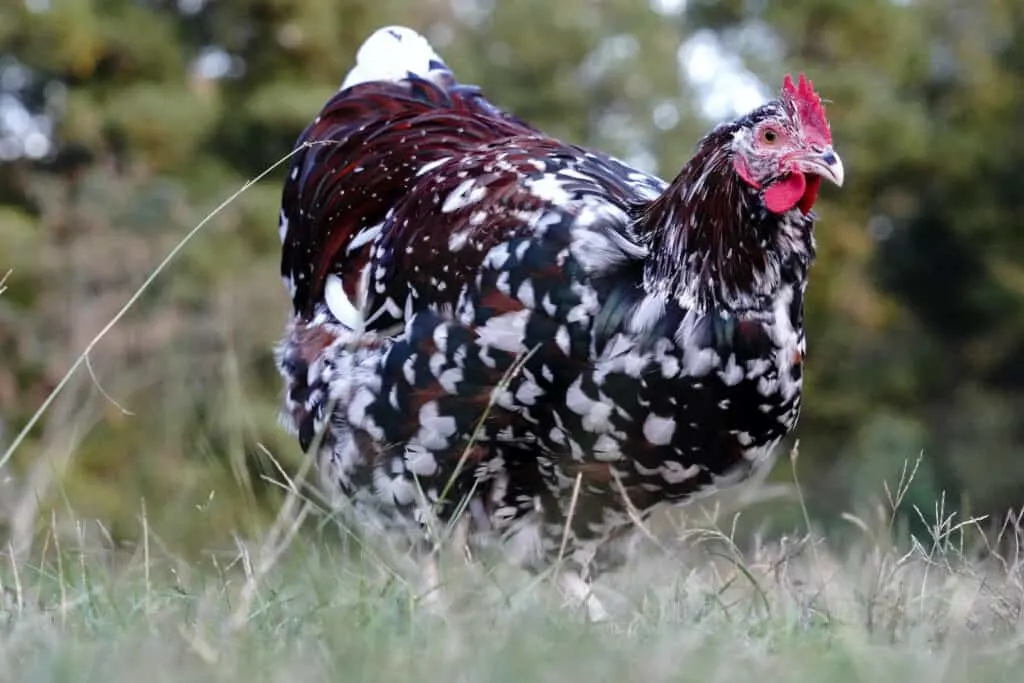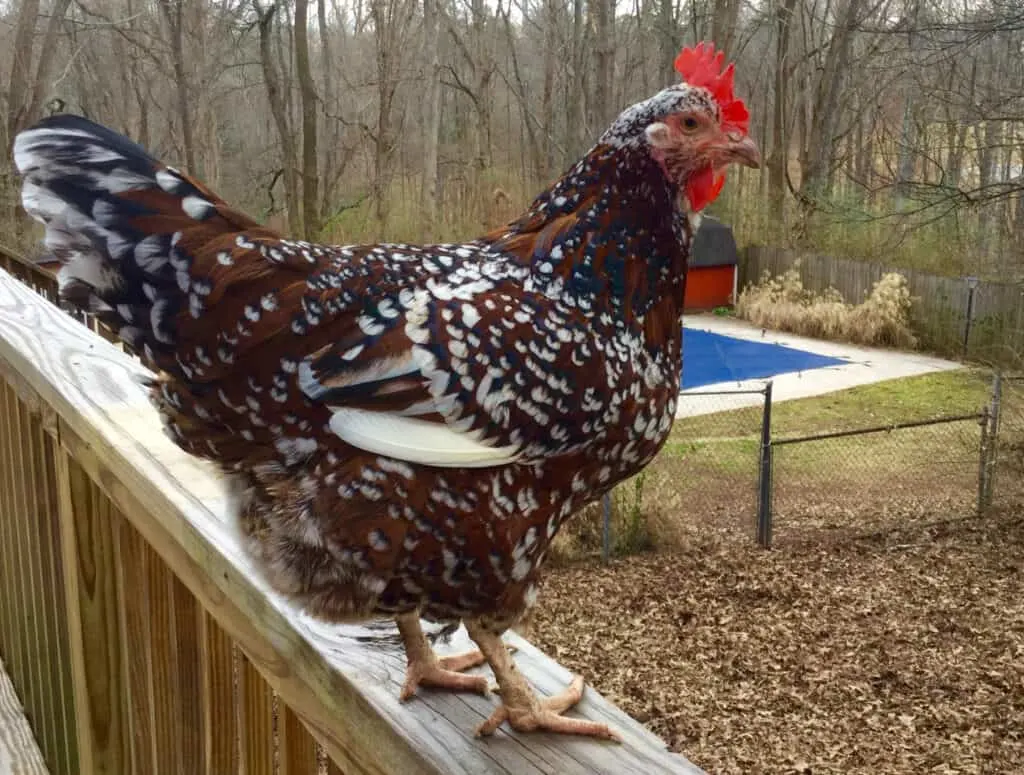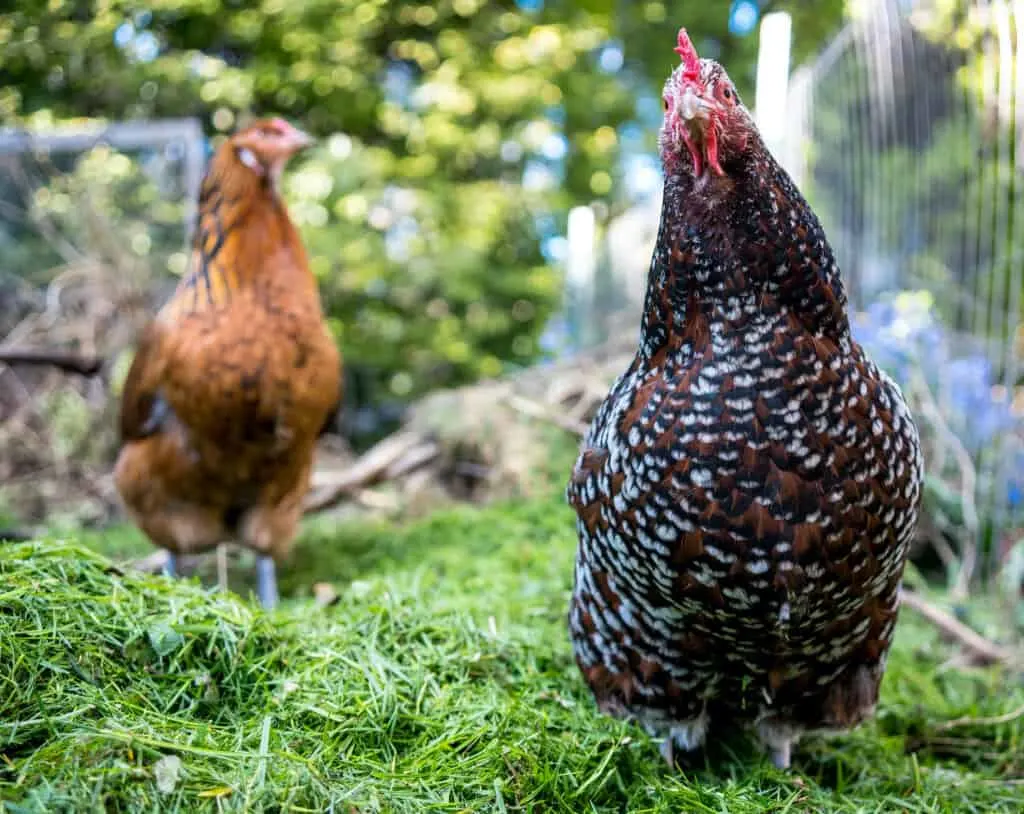What if you could have your cake and eat it, too? With the Speckled Sussex chicken breed, you can – or so to speak!
This beautiful bird is prized not only for its unique, one-of-a-kind beauty but also for its ability to lay plenty of light brown eggs for you. Plus, as a dual-purpose chicken breed, it can also be raised for meat. Economical eaters who are also easily handled, Speckled Sussex chickens should be at the top of your list when it comes to the best backyard breeds.
Is the Speckled Sussex right for your flock?
- Friendly bird with unique plumage
- Good egg production and lays medium to large brown eggs
- Dual purpose bird that can be used for meat
- Great for beginners and children
Table of Contents
Background & History of the Speckled Sussex
Originating in England possibly as early as AD 43, the Speckled Sussex chicken breed is perhaps one of the oldest known breeds, according to Hoover’s Hatchery. A heritage breed chicken, it can be found with many different feather colors and color combinations, something we’ll address in more detail below.
Technically, the Speckled Sussex is a specific variety of the Sussex breed. This chicken originated in the historic county of Sussex and was first known as Old Sussex or Kent Fowl. The Speckled Sussex chicken’s earliest ancestors were shown at the very first poultry standard show at the London Zoo in 1845.
There are several color variants of the Sussex breed today, including:
- Light Sussex
- Red Sussex
- Speckled Sussex
- Brown Sussex
- Silver Sussex
- Buff Sussex
- Coronation Sussex
- White Sussex
The American Poultry Association only recognizes the light, red and speckled Sussex. The Speckled Sussex is the oldest and most classic of the bunch. It fell out of favor among chicken keepers for many years following the development of commercial egg-laying and hybrid strains around World War II. Until then, this bird, along with the Rhode Island Red, was recognized as the predominant meat bird.
Although the modern Speckled Sussex is nowhere near as popular as before World War II, it has experienced a resurgence in popularity as the backyard chicken keeping movement continues to grow. It is listed as “recovering” by the Livestock Conservancy as a result.

Temperament & Behavior
When it comes to friendly chicken breeds, you really can’t beat the Speckled Sussex. Calm, docile, and friendly birds, these chickens are happy to trot along behind you in the garden as they forage for grubs and other tasty morsels.
They are known to be a bit mischievous due in part to their naturally curious dispositions. They are resourceful and active, happy to spend their days scratching around in your garden. However, they do take well to confinement, making the breed a good option if you decide to keep chickens throughout the cold winter months, too.
Speckled Sussex chickens are relatively quiet, just chattering along with the usual backyard chicken noise of the egg-laying song or the alert call. You will find that the Sussex hen tends to go broody, too, something that’s beneficial if you want to hatch your own eggs. They set well, and the Sussex hen makes wonderful mothers.
The only downside to the Speckled Sussex’s peaceful disposition is that it can sometimes fall low on the pecking order. Since it’s not the largest chicken you might have in your chicken coop, nor is it the most assertive, it may fall victim to some bullying from other, more assertive chickens.
Nonetheless, the Speckled Sussex is a friendly breed that’s great for chicken keepers with other pets, chickens, and even small children. It’s also a good option for beginners since it has few breed-specific medical concerns or care issues.

Breed Specifics & Traits
Type
More often than not, Speckled Sussex chickens are raised for egg production, but they can also be raised as meat birds. When raised as meat birds, the meat is somewhat lighter than what you might expect from a backyard chicken. It’s incredibly tender, particularly when the bird is young. On average, Speckled Sussex chickens dress out at around 6-7.5 lbs, an excellent sized carcass for the dinner table.
They’re also great as layers, making them an excellent dual purpose breed. These chickens will lay plenty of medium-large, pale brown eggs for you all year – even in the dead of winter. Because they are friendly and easy to train, they also make good companions as pets or show birds.
Size
Speckled Sussex chickens aren’t the largest chickens you’ll raise, but they certainly aren’t the smallest, either. A medium- to large- bird, it is listed in the heavy breed class. Hens typically weigh around 6.5-7 lbs, while the speckled Sussex rooster can often be somewhat heavier.
Average Life Span
Speckled Sussex chickens reach maturity a bit faster than birds of similar breeds. It generally only needs to be about 20 weeks or so to be ready to lay eggs and generally produce a decent-sized carcass for the dinner table at this time, too, if you decide to raise them for meat. However, it’s advised that you raise them for a month or two longer if this is your plan, which will allow your birds to put on more weight.
If kept as pets or for eggs only, these chickens can live relatively long lives. Some live seven to eight years or more when cared for properly.

Appearance
Some chicken breeds are difficult to differentiate from each other. Rhode Island Reds look almost exactly like New Hampshire Reds, for example. However, when it comes to the Speckled Sussex, there’s no mistaking it.
This chicken has such a gorgeous and unique feather pattern that you won’t have trouble telling it apart from the other birds in your flock. Even as baby chicks, you’ll notice the distinctive dark chestnut-colored markings that are prominent, especially around the eyes. These markings make the young birds look somewhat like cute little chipmunks! Occasionally, chicks are lighter in color, but most have distinctive pale and dark brown stripes on their backs.
What’s truly unique about these chickens is how their appearance changes as they age. As Speckled Sussex chickens get older, their adult markings will show up in full force. Their adult plumage is a deep mahogany with some feathers dipped in white and others in black. After each molt, the white tips will multiply, leading the chicken to have more speckles as it ages.
The wattles, earlobes, and combs of these chickens are all a deep red. It has a horn-colored beak, a flat, broad back, and a broad, deep chest.
Speckled Sussex chickens do not have feathered legs or any extra toes – indeed, the most remarkable characteristic of this breed is its feathering. It has four toes and a single comb. The American Poultry Association, which recognized the Speckled Sussex in 1914, denotes this breed as English class while the Poultry Club of Great Britain recognizes them as heavy, soft-feathered breeds.
There are some bantam versions of the Speckled Sussex, but these are not common and difficult to find.
Traits
Speckled Sussex chickens are dual-purpose birds that do relatively well in most climates. However, they are a bit more fond of cold weather than they are of heat. Although you shouldn’t have too many problems raising them in heat as long as you provide plenty of shade and water, Speckled Sussex chickens perform much better in the cold. This is primarily because of their dense, heavy feathers.
Because Speckled Sussex chickens are somewhat fat-bodied, they aren’t prone to flightiness. They are also easily fenced. This can lead to occasional issues with predators if they happen to get inside of your chicken run – however, as long as your run and coop are secure, you shouldn’t have to worry. It is rare for Speckled Sussex chickens to “fly the coop,” as they say – they’ll stay confined to wherever you cage them in.
They aren’t prone to many diseases or health problems, either, besides what you might find in a typical flock of backyard chickens. You may want to keep a closer eye on these chickens for parasites like mites and lice, as they can be more susceptible due to their heavy feathering.
Speckled Sussex Quick Facts
| Type | Dual Purpose |
| Size | Medium to Large |
| Heritage Breed | Yes |
| Average Weight | 7-8 lbs |
| Weeks To Maturity | 20 |
| Average Life Span | 8+ years |
| Color Variations | Light Sussex Red Sussex Speckled Sussex Brown Sussex Silver Sussex Buff Sussex Coronation Sussex White Sussex |
| Egg Size | Medium |
| Egg Color | Brown |
| Egg Production | 151-220 eggs per year |
| Dual Purpose | Yes |
| Temperament | Friendly and Tame |
| Beginner Friendly | Yes |
| Kid Friendly | Yes |
| Heat Tolerant | No |
| Cold Tolerant | Yes |
| Comb Type | Single |
| Broodiness | Yes |
| Flightiness | No |
| Noise Level | Average |
| Unique Traits | Feathers offer camouflage, additional speckles after each molt |
Eggs
Speckled Sussex hens are prolific layers, typically laying eggs at around 20 weeks of age. This is significantly sooner than chickens of other dual-purpose breeds, some of which take up to a month or more longer to produce their first eggs.
These eggs tend to be medium to large, usually slightly tinted, cream-colored, or pale brown. The average speckled Sussex hen will lay around four or five eggs each week, or up to 240 each year. This can depend, of course, on the individual pullet as well as the weather and conditions in which she is being raised.

Where to Buy
Ready to invest in your backyard flock of Speckled Sussex chicks? You can find them for sale, averaging around $3.00-$4.00 for unsexed birds, at Cackle Hatchery.
Cackle Hatchery is our preferred and recommended hatchery. While most hatcheries require orders of at least 25 chicks, you can buy as few as 3 chicks from Cackle. They are also highly rated on Google and have been in business since 1936.
Summary
Ready to start your backyard flock of hardy (yet beautiful) dual-purpose birds? If so, you may want to consider the Speckled Sussex chicken breed. This beauty is not only a joy to look at but will also lay plenty of eggs (and yield lots of tasty meat!) for your family.
